Is It Easy to Get Into Utm
9 Best Unified Threat Management Software
With such a huge range of UTM applications available, choosing the right one for your business and budget can be challenging. W review the best UTM applications on the market.

Unified Threat Management (UTM) offers a complete security protection system that leaves no gaps for hackers to exploit. Replacing your anti-virus and firewall systems with a full UTM package makes sense because those separate cybersecurity services should be working together in order to address the serious system threats that are constantly evolving.
Here is our list of the nine best Unified Threat Management software packages:
- Datadog Security Monitoring (FREE TRIAL) EDITOR'S CHOICE This Cloud-based cybersecurity system collected event data from every part of your system and identifies any activity that is suspicious. AI-based detection methods narrow down threat identification, so you don't get overwhelmed by false-positive reporting. Start a 14-day free trial.
- ManageEngine Log360 (FREE TRIAL) This on-premises SIEM collects data from many different systems, including cloud platforms. Runs on Windows Server. Start 30-day free trial.
- Fortinet FortiGate UTM This physical appliance is produced by a leading network security provider and creates a "security fabric" for the entire organization. SD-WAN options are also available to extend protection over several sites.
- Check Point UTM Suitable for organizations of all sizes, this scaleable security monitor is available in two plan levels and can be customized to add in more features, such as data loss prevention. Impements on site as a physical or virtual appliance.
- Sophos SG UTM This total cybersecurity package covers all of your IT assets with a range of deployment options that include on-site virtual and physical appliances and a cloud-based service.
- Cisco UTM This package is offered by the network equipment giant and so is particularly strong on network security but also offers monitoring for endpoints. Offered as a physical or virtual appliance or as a cloud service.
- SonicWall UTM A system security package that can be built into SonicWall appliances that connect to the network and monitor all activity. Also offered as a virtual appliance.
- Huawei Unified Security Gateway (USG) A series of network appliances that include onboard system security software. That software can also be run separately as a virtual appliance.
- WatchGuard Firebox UTM This is a range of physical appliances that implement system-wide security monitoring. Also available as a cloud-based service or a virtual appliance.
UTMs and NextGen-Firewalls
The traditional approach is to deploy several single-function security products from different vendors. However, this method requires installing and integrating several products, which of course involves individual familiarity, learning different management consoles, and managing updates and upgrades from several vendors. Next-generation firewalls (NGFWs) are also a viable option as they are much more effective than traditional firewalls, but still lack important features that are critical to detecting and responding to all the latest threats. But in recent times, organizations are embracing a concept known as Unified Threat Management (UTM) solution that combines two or more security services into one application or appliance.
UTM is a term used to describe an all-in-one approach to information security, where a single converged platform ( software or hardware) provides multiple security functions such as network firewalls, intrusion detection and prevention, gateway anti-virus, business VPN, email and web content filtering, etc. UTM's seemingly appeal stems from the fact that it simplifies information security management by providing a single management and reporting point for the security administrator rather than managing multiple products from different vendors. Instead of having several single-function applications or appliances, network administrators can centrally administer their security defenses from one box.
Evaluating UTM tools
When evaluating a UTM product, you need to ensure that the device's different functionalities address your security risks and policy requirements. You don't want to get caught up in the sales and marketing hype that tends to surround most security products. There are key questions you need to consider, such as: What security problem are you trying to solve? Is a UTM solution right for your organization? What security features are most important? Do you require the UTM to support geographically dispersed branch locations and remote workers? What is the infrastructure bandwidth for your environment, and how many users and devices does the organization need to support today and in the future? Is it easy to deploy, manage and maintain? Other factors to consider include performance, scalability, vendor support, and of course cost.
The best UTM Software:
Unified Threat Management breaks down the silos between security services for different system elements. We discover the best UTM software available on the market today.
There are quite a few UTM systems on the market today. However, deciding what to look for and narrowing down the field can be time consuming.
What should you look for in a Unified Threat Management system?
We reviewed the market for UTM solutions and analyzed tools based on the following criteria:
- A package that will protect endpoints, networks, and cloud resources
- A centralized system that offers a single console for threat management
- The option to extend centralized threat protection over several sites
- A secure communication path for data transfers over the internet
- Zero-day threat protection
- A free trial or a money-back guarantee to reduce the risk of being fleeced
- Value for money from a single package that replaces individual cybersecurity systems
With these selection criteria in mind, we identified a shortlist of centralized UTM packages that provide excellent cybersecurity protection at a reasonable price.
1. Datadog Security Monitoring (FREE TRIAL)
Datadog is a SaaS platform of monitoring and system management services that are charged for by subscription. The service includes a Security Monitoring package, which is part of a wider Security Monitoring Platform.
The Security Monitoring system is appropriate for use by IT Operations departments for supervising the security of the enterprise's entire IT infrastructure. The Security Monitoring Platform includes extra testing band protection services for DevOps environments.
The Datadog Security Management service is a SIEM system. This means that it collects log messages and system monitor outputs, such as SNMP reports, and gathers them together into a single pool of data for threat detection. This means that activity data from every part of your IT system – endpoints, networks, and applications, is included in the protection system.
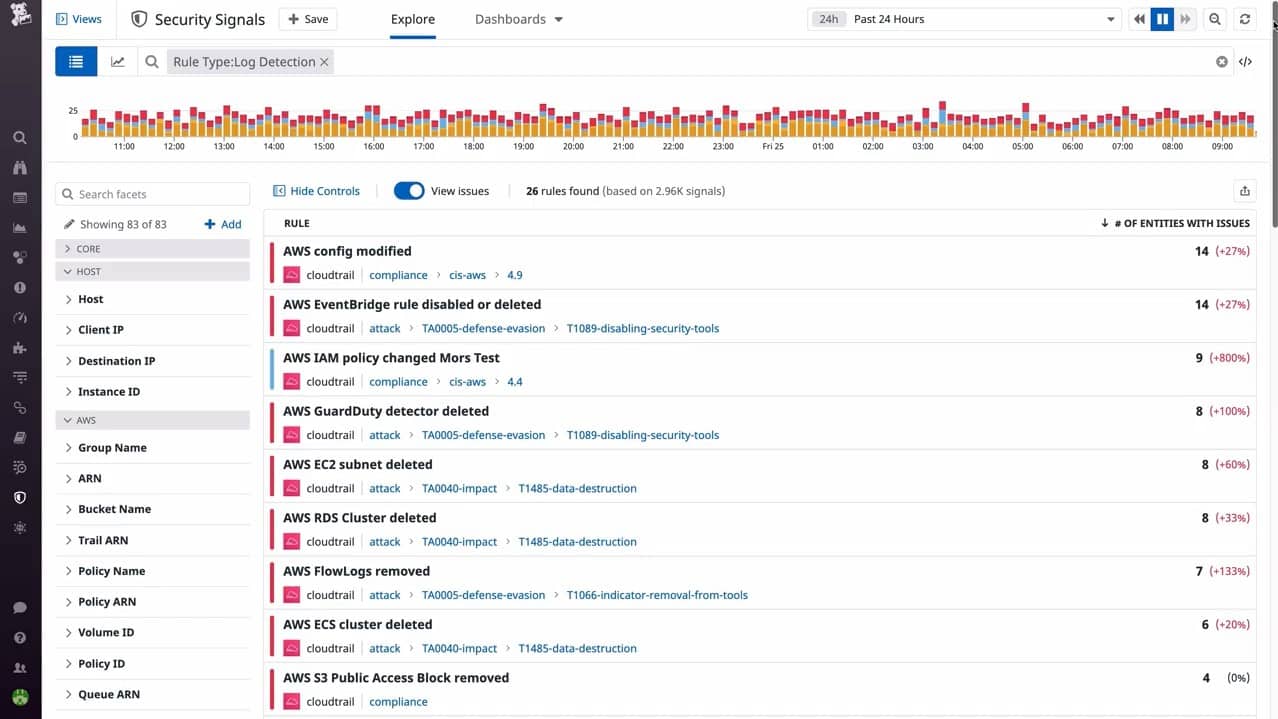
While the Datadog Security Monitoring service doesn't replace your existing firewall, it will integrate that service into its unified security management system. Activity data from the firewall feeds into the SIEM and automated response instructions can be sent back to it.
Key Features:
- Monitor multiple sites
- Monitor security for cloud platforms
- SIEM package
- A cloud-based service
- Orchestrates with third-party tools
By coordinating existing services, Datadog Security Monitoring creates efficiency. The system gets even more cost-effective if you combine the security features with other services offered by Datadog, such as its Network Monitoring packages because all of the Datadog systems use the same on-site agent for data collection.
Datadog offers a menu of services that are all run from its cloud platform and you can try all of them on a 14-day free trial.
Pros:
- Highly scalable cloud-based monitoring that can applications across multiple WANs
- Flexible à la carte pricing and feature options
- Offers over 500 integrations, great for large networks utilizing numerous third-party applications
- Templates work extremely well out of the box, customization is possible but not always necessary
Cons:
- Could benefit from having a longer 30-day trial period
EDITOR'S CHOICE
Datadog Security Monitoring is our top pick for a Unified Security Management (UTM) service because it efficiently provides monitoring for any resource no matter where it is located, giving you the ability to centralize the security protection for all of your IT assets, including on-premises systems and cloud resources. The ability of this service to gather activity information from all of your IT assets creates an easy way to implement security management without having to re-install software or alter system settings. Combining the Security Monitoring service with other Datadog packages increases value for money and efficiency.
Download: Get a 14-day FREE Ttrial
Official Site: datadoghq.com/free-datadog-trial/
OS: Cloud based
2. ManageEngine Log360 (FREE TRIAL)
ManageEngine Log360 is an on-premises system that runs on Windows Server. The service isn't limited to examining events on its host because it can ingest log messages from all other endpoints on the network and also on cloud platforms. This means that Log360 can unify threat hunting for many platforms. The package includes a library of agents for all of the major operating systems, including Linux and cloud systems, such as AWS and Azure. The agents interact with the operating system and more than 700 software packages to collect log messages, which are forwarded to a central log server, where they are converted into a unified format.
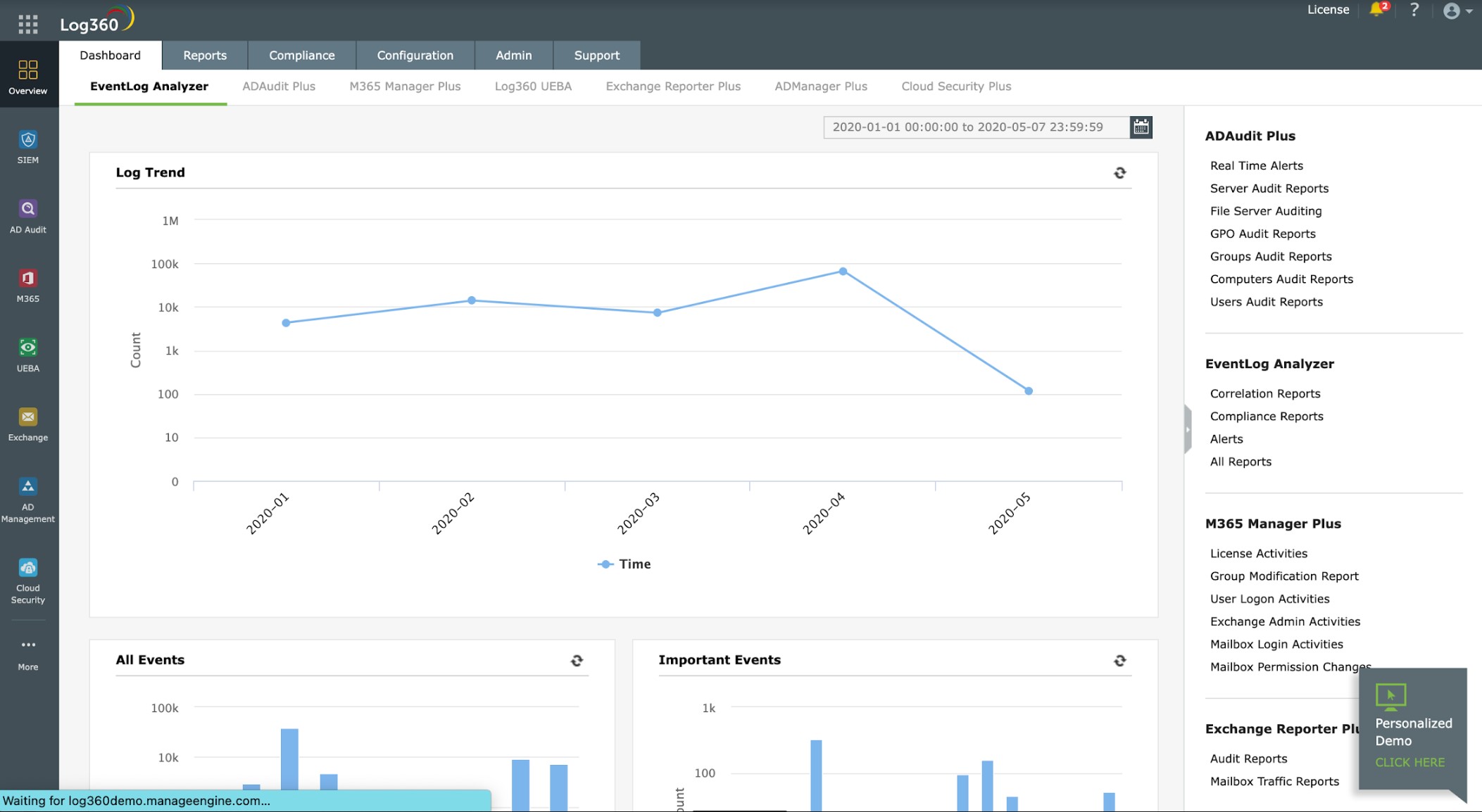
While all of the tools in this list centralize threat management, most of the options available today are cloud based. Not everyone is comfortable with cloud services and if you are someone that prefers to host your security software in-house, this is the best option.
Key Features:
- A threat intelligence feed
- Centralizes cloud and premises threat hunting
- File integrity monitoring
- Customizable
The Log360 package provides many security features, which include file integrity monitoring. The tool records all data access and file change events, which is greater for data security standards compliance. This system also produces compliance reports for GDPR, GLBA, HIPAA, PCI DSS, FISMA, and SOX.
Pros:
- Live tail log records shown in the dashboard
- Analytical tools for manual analysis
- Log management and filing
- File protection
Cons:
- Although there is an agent for Linux, the server isn't available for that OS
ManageEngine Log360 is available for a 30-day free trial.
3. Fortinet FortiGate UTM
The Fortinet FortiGate UTM is among the leading UTM products or applications in the market. It has been recognized by Gartner as a leader in its annual UTM Magic Quadrant report since 2008. It has also been named a 2020 Gartner Peer Insights Customers' Choice. FortiGate UTM supports deployments across physical, virtual, and cloud environments. It's available in different models ranging from entry-level hardware appliances targeted at small offices, to ultra-high-end appliances designed for data centers and multi-tenant cloud environments, as well as a software virtual appliance for deployment on your own hardware.
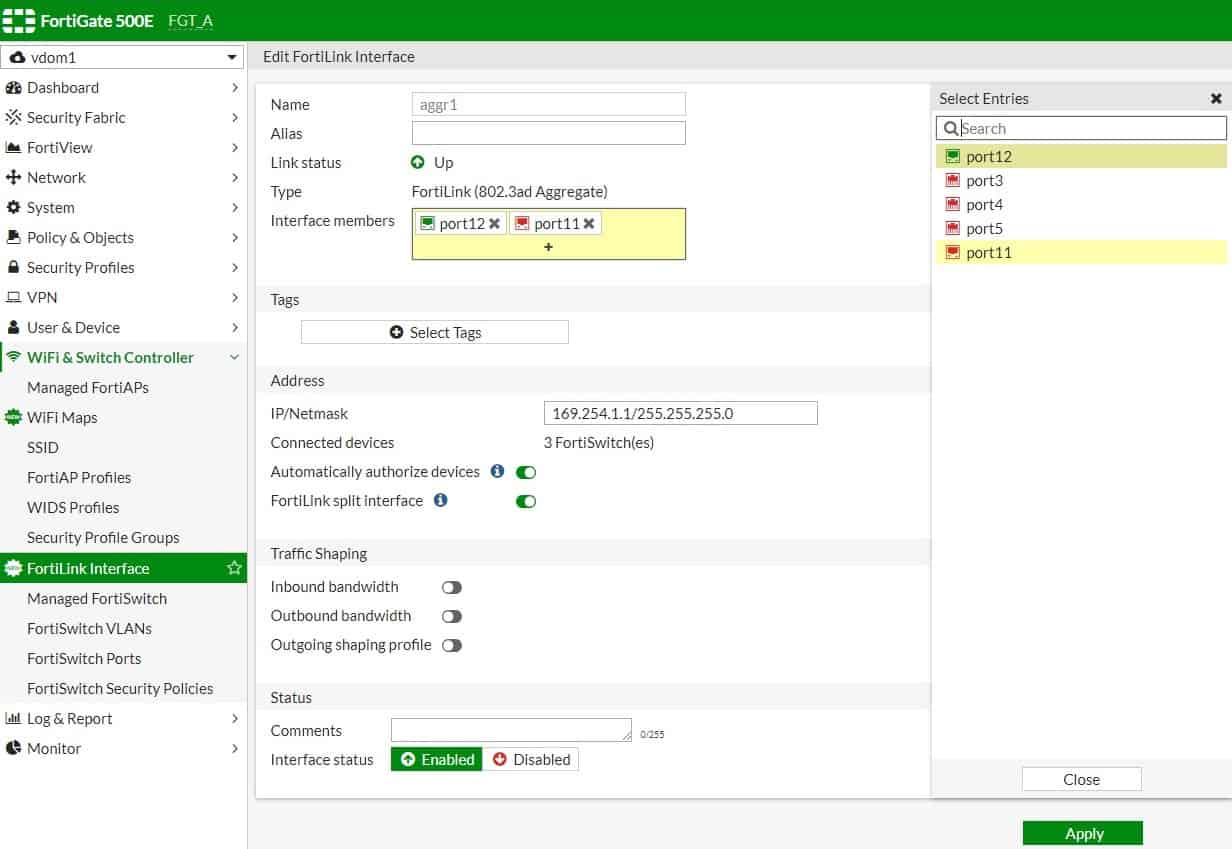
FortiGate UTM is powered by FortiOS software, which also enables the Fortinet Security Fabric—an adaptive architecture providing integrated detection and automated responses to cybersecurity threats. It utilizes machine learning and AI to provide behavioral-based cyber threat detection and prevention.
Key features include:
- Monitor physical and virtual systems
- On-premises and cloud resources
- Physical or virtual appliance
- Integrates with Fortinet Security Fabric
- Software-defined wide area network (SD-WAN),
- Next-generation firewall (NGFW)
- Intrusion prevention and detection
- Data loss prevention (DLP)
- Virtual private network (VPN) and tunnel endpoint (SSL & IPSec)
- Email, web, and content filtering
- Advanced persistent threat protection
- Anti-malware, IP reputation, and SSL inspection
- Integrated WLAN controller
- Cloud sand-box
Fortinet licenses UTM security features which it calls FortiGuard Services, on a per-device basis. FortiGuard Services are available as a single subscription or software bundle with or without hardware. FortiCare device-based support is the foundation of the support services, providing firmware updates, technical support, and foundational FortiGuard subscriptions. Customers can also purchase advanced premium support services to complement the standard FortiCare support plan.
Pros:
- Offers a large number of integrations making it a great addition to your SIEM of other security tools
- Simple yet effective interface – even for larger enterprise networks
- Includes additional support and services via a monthly subscription
Cons:
- The product is feature dense and can take time to fully explore
Related post: The best Fortinet analyzers
4. Check Point UTM
Check Point has one of the best UTM solutions for small, midsize, large-scale, and data center organizations. It is recognized as a leader in the Gartner UTM Magic Quadrant for its enterprise-quality security features and ease of management. Check Point's UTM software bundle comes in two flavors:
- Next-Generation Threat Prevention (NGTP): This solution bundle includes security features such as firewalls, IPS, IPsec VPN, anti-bot, antivirus, email security and anti-spam, application control, mobile access, URL filtering, identity and content awareness, policy management, among others.
- Next-Generation Threat Prevention & SandBlast (NGTX): In addition to the above features, this solution bundle is enhanced with OS-level sandboxing technology called SandBlast Threat Emulation and Threat Extraction to prevent zero-day and other targeted attacks.
Check Point also has an industrial appliance called the UTM-1 Edge N. It runs the same UTM software, but it's designed for industrial ethernet and SCADA environments. One good thing about Check Point UTM products is it's easy to use user interface and consistent software architecture for all models both high and low ends. It also tried to incorporate various features and functionality for a wide range of network sizes and use cases.
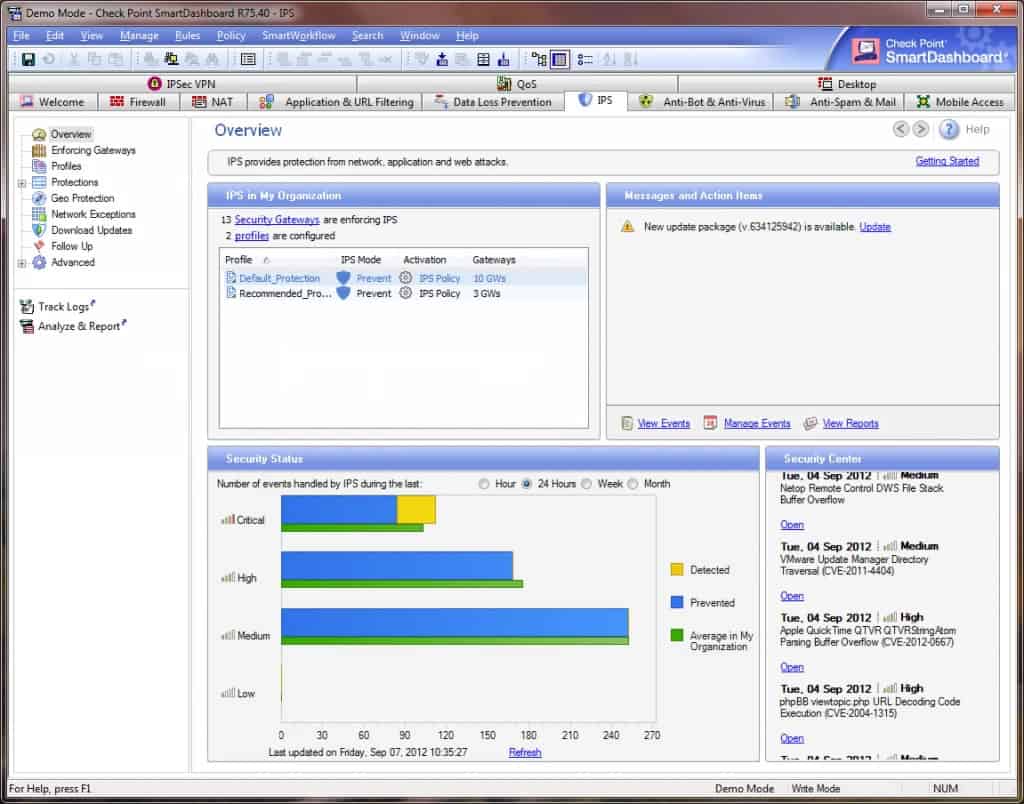
Check Point's licensing is designed to be scalable and modular. To this end, Check Point offers both predefined packages as well as the ability to custom build a solution, which it calls software blades. Both NGTP and NGTX come with blade licenses. So for example, say you want to use a firewall, IPS, and IPSec VPN; you would need a software license for those blades.
Key Features:
- Combines security strategies
- Optional sandboxing
- Verison for industrial systems
Check Point is best suited for midrange organizations seeking strong security and robust management features. The main issue for Check Point is its sheer number of different products and a wide array of features. If you don't need every UTM security feature it offers out of the box, you might be better off purchasing a more focused product that has fewer key features.
Pros:
- Flexible threat management solution for any size network
- Offers two UTM tiers that include sandboxing, and threat emulation to prevent zero-day attacks
- Best for organizations looking to use all security features in one UTM product
Cons:
- Would benefit from more intuitive data visualizations
5. Sophos SG UTM
Most people usually associate Sophos with just endpoint security services, but the company also offers one of the best UTM products in the market. In fact, Sophos is rated by Gartner as a leader in the UTM market because of its feature-rich security, ease of use, and integration with its endpoint security product.
Sophos gives you the flexibility to deploy its UTM solution as hardware (SG series), software (UTM image or virtual appliance), or cloud-based appliance, including a free version for home use. One good thing about this product is that Sophos provides a free tool called Sophos UTM Manager (SUM) to centrally manage all your UTM appliances from a single, centralized management console. It's a good thing because most vendors usually require some form of licensing or subscription to unlock this feature. The Sophos SG series UTM appliance comes in Desktop, 1U, and 2U models, as well as a software virtual machine.
- The Desktop model such as the SG 105/105w, SG 115/115w, SG 125/125w, and SG 135/135w ("W" signifies support for a wireless network) is the entry-level range targeted at SMBs and remote offices.
- The 1U model such as SG 210, SG 230, SG 310, SG 330, SG 430, and SG 450 is the mid-range solution ideal for many medium-sized organizations.
- The 2U model such as SG 550 and SG 650 is the high-end solution targeted at larger organizations and data center environments.
Some of the key features or modules of Sophos UTM include but are not limited to:
- Virtual appliance, physical device, or SaaS platform
- Free for home use
- Includes email protection
- Next-generation firewall (NGFW) protection
- Site-site and remote access VPN
- Mobile network access control
- Endpoint protection
- Data loss prevention (DLP)
- Email Protection, encryption, and anti-spam
- Advanced threat protection
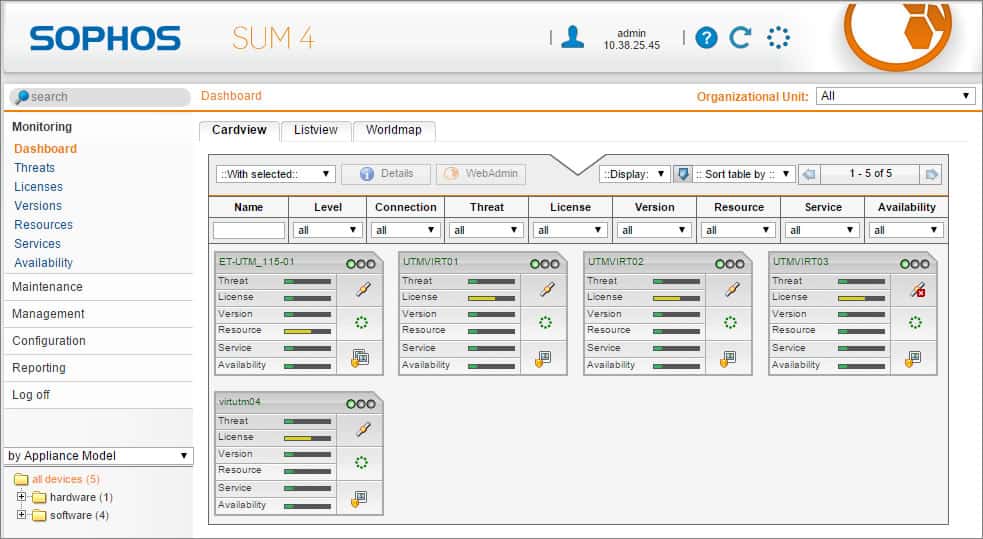
Sophos UTM licensing is based on subscription. You can either subscribe individually to those modules or purchase a single pre-packaged FullGuard license. The Sophos standard support provides access to manual updates, knowledge base, community forum, and return and replace services. Premium support gives you 24/7 technical support direct from Sophos Support engineers, automatic updates, and advanced replacements. If you think Sophos UTM is right for your business, follow the steps below to complete the buying process.
- Choose your deployment model: hardware, software, virtual or cloud-based appliance
- Choose your license: Pre-packaged license or license modules individually
- Choose your add-ons: Take advantage of add-ons such as subscription extensions, centralized management, and reporting options, among others.
Pros:
- Offers versatile deployment options
- Allows users to choose the features they pay for through simple add-ons
- Free for home use
Cons:
- Could benefit by modernizing the dashboard view
6. Cisco UTM
Cisco is a household name when it comes to network infrastructure products and services. It is therefore not surprising to know that it is also a force to reckon with in network security, especially in the UTM market. It is recognized as the lead challenger in the most recent Gartner UTM Magic Quadrant published in 2018. It was also named a 2018 Gartner Peer Insights Customers' Choice for UTM.
Cisco offers several UTM hardware appliance options with Firepower series, ASA 5500-X series with FirePOWER services, and Meraki MX series, as well as software virtual appliance for public and private cloud infrastructure. All of these can be managed from a central platform called Firepower Management Center (FMC). Cisco lets customers try out Meraki MX products on their own networks at no charge.
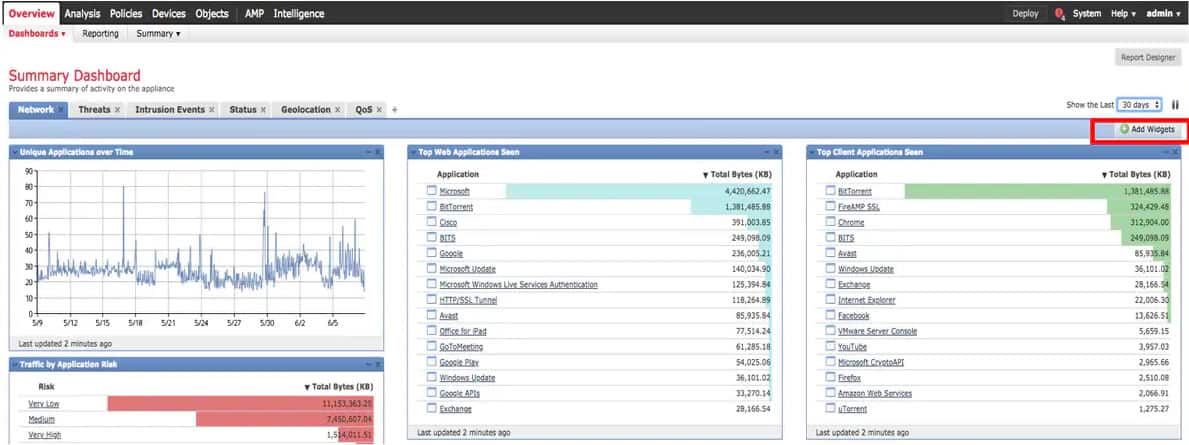
Cisco is a particularly good fit for companies seeking a broad range of security products and services that integrate with the firewall. But incidentally, the sheer number of different products and a wide array of features makes buying decisions cumbersome. Key features include but are not limited to IPS, VPN, URL filtering, DDoS protection, application control, identity services, endpoint protection, web gateway, email security, network access control, and high availability.
Key Features:
- Physical or virtual appliance
- A list of add-on services
- Firewall-centered
All purchases can be made via accredited Cisco partners. Cisco UTM licensing is subscription-based and it comes with standard and premium support. Licensing covers specific security features and services used by the appliances. Customers are required to purchase a license for cloud services on a per-device basis. Existing ASA customers have the opportunity to upgrade the software to the Firepower 9300 without replacing the ASA device. Cisco even provides small businesses with flexible payment options via the Cisco Easy Pay plus. Cisco is well known for its strong support system for customers. As with other products, Cisco provides full online documentation for installing and configuring all of its UTM software and appliances.
Pros:
- Integrates well with other Cisco security products
- Offers QoS and access control alongside its UTM offerings
- Best suited for medium to large-sized networks
Cons:
- Networks not using Cisco products miss out on integration opportunities
7. SonicWall UTM
SonicWall has been in the UTM business from the earliest days. They have produced good value UTM product sets and models to meet the needs of businesses of all sizes. It is recognized as a challenger in the Gartner 2018 UTM Magic Quadrant.
Just like other vendors, SonicWall UTM supports deployments across physical, virtual, and cloud environments. Its appliances are powered by a software called SonicOS that enables all the UTM security and networking features. The SonicWall UTM are grouped under the following categories:
- SonicWall TZ SOHO Series: These are entry-level UTM products (in wired and wireless models) that combine threat prevention and SD-WAN technology, targeted at small to mid-size organizations and remote offices.
- Network Security Appliance (NSA) series: These are hardware appliances that range from NSA 2650 series to NSA 9650 series, and are targeted at mid-sized networks to distributed enterprises and data centers.
- Network Security Services Platform (NSSP) series: These are also hardware appliances made up of NSSP 12400 and NSSP 12800 series that combine cloud intelligence with appliance-based protection, designed for large distributed enterprises, data centers, and service providers.
- Network Security Virtual (NSV) series: These are full-featured SonicWall UTM software applications ranging from NSV 10 to NSV 1600, designed to deal with vulnerabilities within virtual environments.
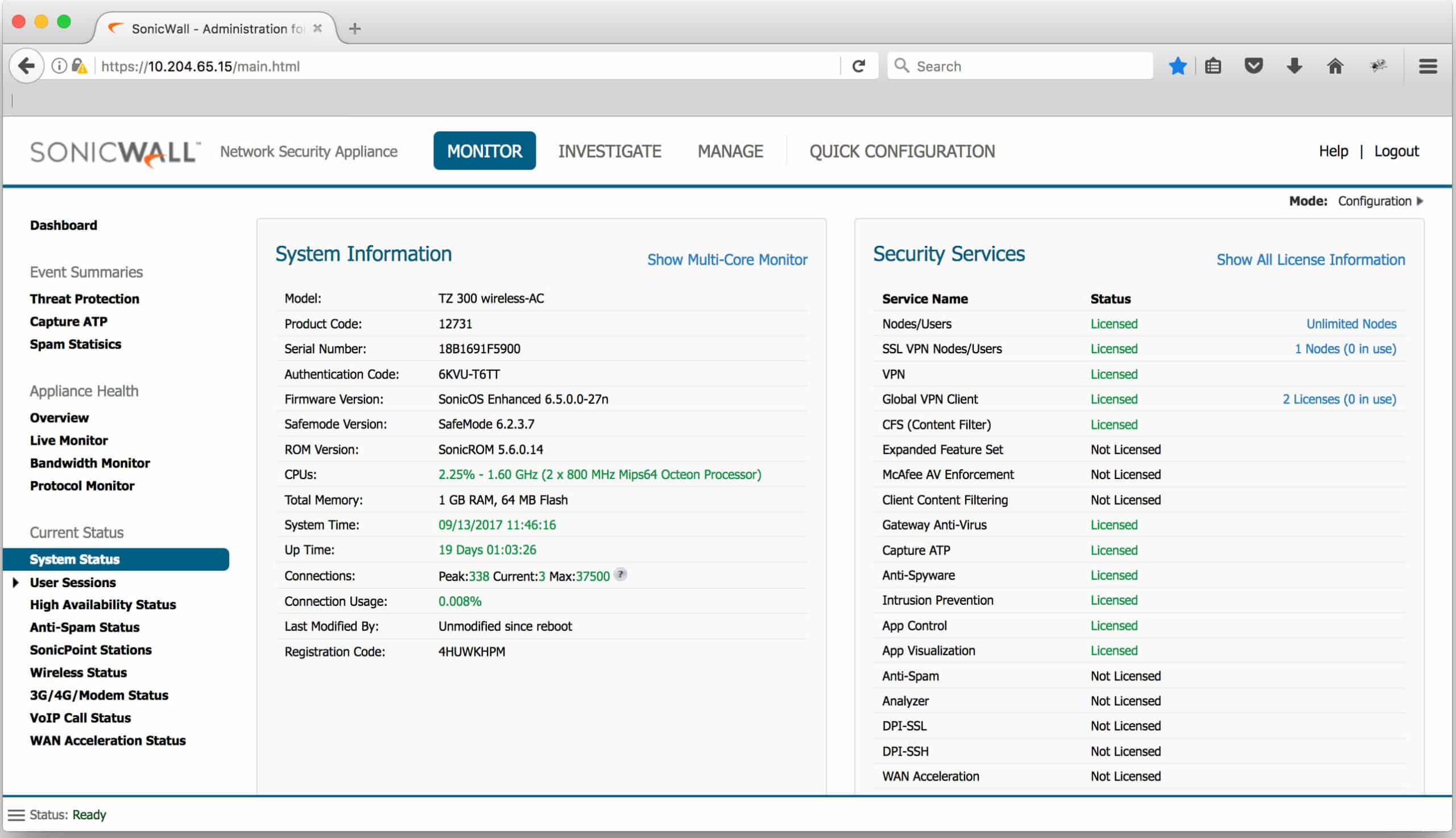
One notable feature and capability of SonicWall UTM is the availability of an integrated cloud-based centralized management service called Capture Cloud Platform, and online live demos, that helps you experience real product demonstrations without going through the trouble of putting a test box in your environment. Other key features include:
- Next-generation firewall (NGFW)
- Cloud service or physical or virtual appliance
- Intrusion prevention system
- Virtual private network (VPN)
- Web content filtering
- Anti-malware
- Application identification
- TLS/SSL/SSH decryption and inspection
- Anti-malware, IP reputation, and SSL inspection
- Integrated WLAN controller
- Traffic visualization and analytics
- Networking, Wireless, and VoIP
- Management and monitoring
SonicWall UTM licensing is subscription-based and it comes with standard and premium support. Before deciding to purchase or renew the SonicWall UTM subscription, you first need to determine the appliance type, model, and subscription that is right for your business.
Pros:
- Offers specialized UTM products based on network size and needs
- Offers live demos of their products (great for training and testing)
- Great support and training available
Cons:
- Migrating configurations and settings to other SonicWall advanced models requires careful planning.
8. Huawei Unified Security Gateway (USG)
Huawei UTM solution which it brands as Unified Security Gateway (USG) provides integrated security for midsize, large enterprises, chain organizations, cloud service providers, and large data centers. It is recognized as a challenger in Gartner's most recent UTM Magic Quadrant alongside Cisco and SonicWall in 2018, and it has also earned the coveted NSS Labs' "Recommended" rating in 2019. Huawei is a well-known brand in Europe, the Middle East, Africa, and Asia (EMEAA) markets.
Huawei USG UTM solution comes in desktop, rackmount, data center (DC) chassis, and software virtual appliance model, giving you the flexibility to deploy as hardware or software virtual appliance in a physical, or virtual environment.
- Desktop model: The Huawei HiSecEngine USG6500E series such as USG6510E and USG6530E is the desktop hardware appliance model UTM targeted at SMBs, branch offices, and franchise businesses.
- Rackmount model: HiSecEngine USG6500E series (fixed-configuration), USG6600E series, and USG6700E series (fixed-configuration) are hardware rackmount appliance designed for small and medium-sized enterprises, chain organizations, institutions/campuses, and data centers.
- DC Chassis model: The USG9500 series such as USG9520, USG9560, and USG9580 is an all-in-one data center model that delivers up to 1.92 Tbit/s in firewall throughput to cloud service providers and large-scale enterprise campus networks.
- Software virtual appliance model: The Huawei USG6000V series such as USG6000V1 to USG6000V8 are a software virtual appliance model designed to run in virtual environments, providing virtualized gateway services such as vFW, vIPsec, vLB, vIPS, vAV, and vURL Remote Query.
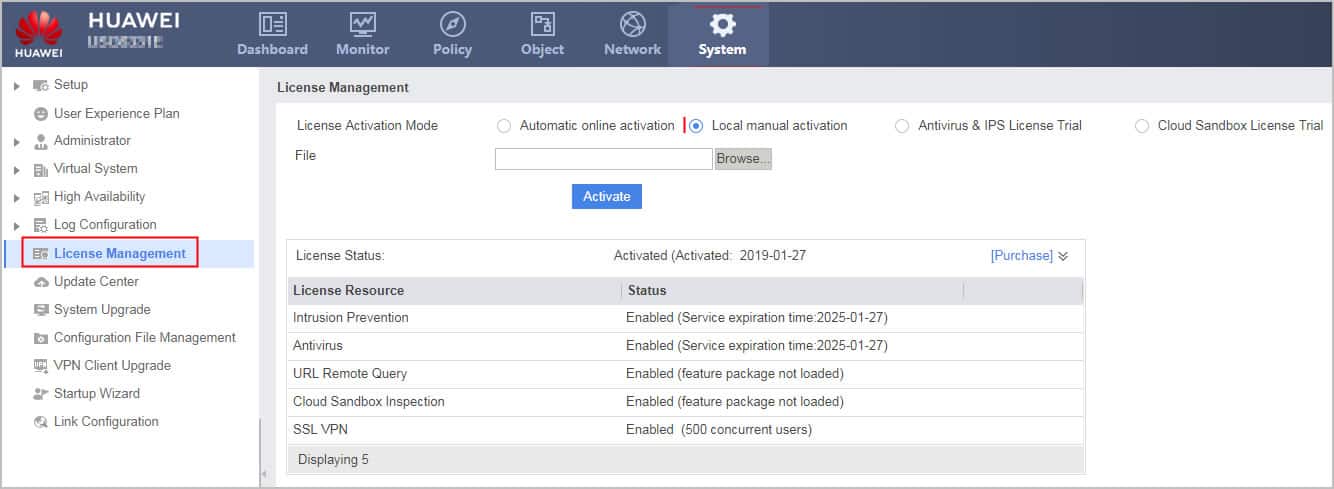
Key Features:
- Suitable for large data centers
- AI-based threat defense
- Traffic management
One of the remarkable features of the Huawei USG UTM solution is the innovative AI capabilities it brings to threat defense. Other features include NGFW, application control, IPS, bandwidth management, URL filtering/web protection, antivirus, VPN, DLP, DDoS mitigation, policy management, among others. All Huawei USG products can be purchased directly from Huawei or via accredited partners.
Pros:
- Leverages AI to identify threats
- Offers four models to serve small businesses as well as large enterprises
- The interface and object-based policies are easy to understand
Cons:
- May face restrictions in the United States, better suited for companies outside the US
9. WatchGuard Firebox UTM
UTM solution from WatchGuard delivers an all-in-one network security platform and protection for mostly small, midsize, and distributed enterprises. It does not directly address large conglomerates or big data centers. It is among the industry's finest when it comes to performance. WatchGuard is recognized as the only visionary in Gartner's most recent Magic Quadrant for UTM published in 2018.
WatchGuard Firebox UTM comes in tabletop, rackmount, and software virtual appliances to give you the flexibility to deploy the solution as a hardware appliance in a physical environment, or as software in a virtual or cloud infrastructure.
- Tabletop Firebox appliances: Just as the name implies, these are small form-factor, high performance, tabletop hardware appliances ranging from T15 to T80 designed for home office, SMB, and branch office locations.
- Rackmount Firebox appliances: The 1U rack-mount appliance ranging from M270 to M670 is designed for small and growing midsize businesses, and M4600 and M5600 is targeted at distributed enterprise organization.
- Virtual/cloud Firebox solution: FireboxV and Firebox Cloud is the software version of the Firebox UTM with all of the security and performance required for any size organization moving their IT infrastructure to a virtual environment—private or public cloud.
Some of the key features of WatchGuard's UTM solution include standard IPS, URL filtering, Gateway AV, application control, and antispam, and features for combating advanced threats such as file sandboxing, data loss prevention, ransomware protection, and much more
WatchGuard sells subscriptions for the security software modules for UTM appliances, either individually or as a suite. Your Support license gives you access to updates and enhancements, and all new releases at no cost. All WatchGuard hardware includes a one-year hardware warranty.
Key Features:
- Suitable for small to midsized businesses
- Physical or virtual appliance
- Malware protection
All WatchGuard UTM appliances come with a minimum of 90 days subscription and support, which includes software updates and hardware replacement, among other services. WatchGuard also offers one-year, and three-year Basic and Total Security subscriptions to unlock security services. Customers can purchase a subscription to Standard, Plus (24/7), Gold, or Premium that offers a higher priority to your support case. If you are considering WatchGuard UTM solution for your business, the steps below will guide you in your buying decision:
- Choose your product or appliance type
- Select your preferred security package—Total Security Suit or Basic Security Suite
- Contact a WatchGuard certified reseller
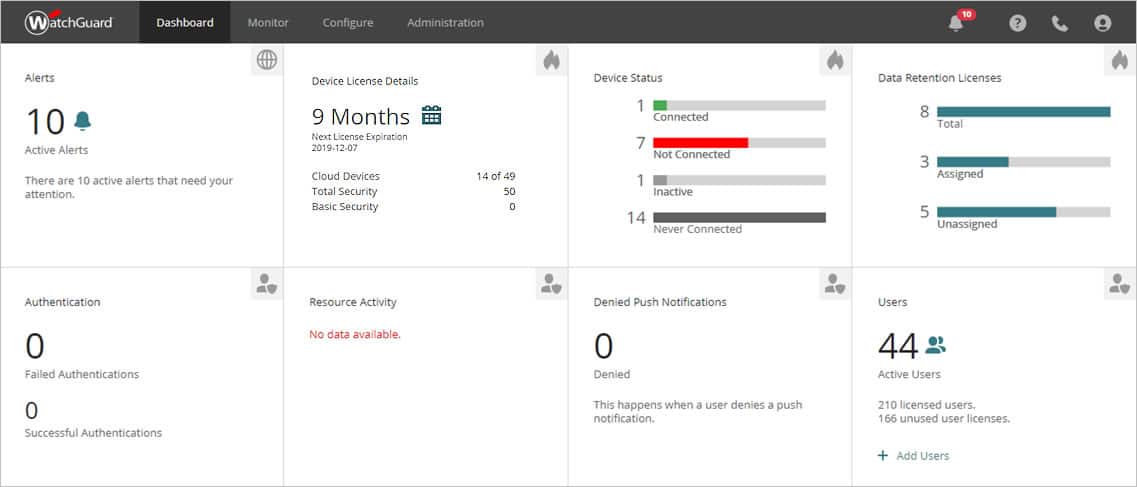
Pros:
- Basic licensing provides free ongoing updates
- Works for both virtual and physical environments
- Offers small form factor products (great for small businesses)
Cons:
- Must purchase a higher tier to receive expedited support
Unified threat management FAQs
What is unified threat management system?
A unified threat management (UTM) system is a security platform that replaces multiple individual security tools, such as anti-virus, firewall, email and Web filtering, data loss prevention, and intrusion detection. The package can be delivered from the cloud or run on an appliance. Some UTMs are available for installation over a hypervisor to operate as a virtual appliance.
Which UTM is best?
We recommend:
- Datadog Security Monitoring
- ManageEngine Log360
- Fortinet FortiGate UTM
- Check Point UTM
- Sophos SG UTM
- Cisco UTM
- SonicWall UTM
- Huawei Unified Security Gateway (USG)
- WatchGuard Firebox UTM
Is a UTM a firewall?
Unified threat management (UTM) systems are sometimes called next-generation firewalls (NGFW). The big difference between the two is that firewalls examine and control incoming traffic but UTMs also examine outgoing traffic so that they can block data theft.
Source: https://www.comparitech.com/net-admin/unified-threat-management-software/
0 Response to "Is It Easy to Get Into Utm"
Publicar un comentario